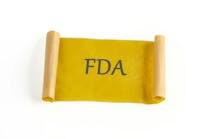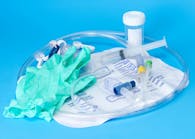Executives and professionals in healthcare supply chain gaze somewhat longingly at other industries for glimpses at what might emerge within their realm of influence in the coming years but maybe that’s a distraction and not the feared disintermediation that some fathom might occur. At best, it would foment disruption of the status quo.
During his popular educational session at AHRMM in late July, titled, “NextGen Supply Chain and Leadership Capabilities: Digital, Innovative and Disruptive,” Randy Bradley, PhD, Associate Professor of Information Systems & Supply Chain Management, Haslam College of Business at The University of Tennessee, Knoxville, said something rather profound and thought-provoking. Paraphrasing, he detonated this idea: What if [insert disruptor here] really isn’t looking to do what healthcare currently does, only better? What if [insert disruptor here] actually is looking to do what healthcare doesn’t?
Yikes. Talk about flipping the stereotype.
So, for example, if an organization such as Amazon (which was cited specifically) wasn’t really in the market to replace/supplant distributors, dot-coms, GPOs, shippers, supply chain management expertise within hospital settings, then what’s with all the hullabaloo the last few years? That’s the point. Instead of holding up Amazon as the paragon of the future-ready supply chain in healthcare — and rest assured, most people agree that Amazon does what it does fairly well — why not explore the gaps in current healthcare supply chain operational continuity that need to be filled, and by whom?
For some, new and emerging techniques and technologies will shape how the future of healthcare supply chain shakes out. For others, new and emerging mindsets and creative thinking will drive it first. And for others, it may be a combination of all of that against the backdrop of economic warfare where the desire for revenue generation and profit growth battles against the dread of reimbursement reductions and budget cuts.
Of course none of this supersedes mastery of the fundamentals of supply chain operations; that is, ensuring the right products in the right quantities are in the right places at the right times and for the right prices so that clinicians (e.g., nurses, etc.) don’t have to embark on a “vision quest” to locate them.
Among the variety of techniques and technologies that may or will redefine and reinvigorate healthcare supply chain operations within the next 10 years, which will emerge as a “need to have” versus a “nice to have?”
16 areas of advancement
Healthcare Purchasing News selected 16 of the trendy and true topics that have been tapping into the mindsets and operations of supply chain and garnered roughly the same number of industry experts and observers from the healthcare provider and supplier communities to weigh in with their impressions.
Neil Olderman, President, Innovative Health Strategies, and Partner, Drinker Biddle & Reath LLP, looked at the list of 16 and agreed that all of the processes and products contribute to the future-ready healthcare supply chain because they all have a home or roots in the consumer world, used by consumers to enhance capabilities and efficiencies.
“In my view, this is the focus in healthcare’s next transformation, and the supply chain will not escape the scrutiny and the task,” Olderman noted. “How has the healthcare supply chain been designed to impact the patient experience in a positive way (driving lower cost, better outcomes and user experience, and enhancing the care and easing the consumer’s burden in accessing quality care)?
“All of these technologies and processes will be used in the next 10 years in healthcare and in the supply chain — and many are being deployed today,” he continued. “The driver will be the need to compete in a consumer-driven environment where patients are armed with price and quality information and the ability to seek care remotely through telemedicine and other similar capabilities. All of these processes and technologies become essential to addressing the needs of the patient/consumer in this context.”
Joe Pleshek, President and CEO, Terso Solutions, sees beyond real-time location and tracking.
“What does success look like? Success is the creation of a Real-Time Healthcare System (RTHS),” Pleshek told HPN. “This system uses situational intelligence to improve decision making around patient care and healthcare operations. It is able to sense the need for a change proactively and has the means to execute that change. It works to eliminate waste and latency, accelerate business processes, balance resources versus demand, improve care quality and the patient experience.”
Innovative Health Strategy’s Olderman insists that future-ready anything in healthcare will hinge on consumer demand and their demands.
“Every aspect of the healthcare provider business will be forced to answer the question: What have you done to better serve the consumer knowing that the consumer wants high-quality, affordable healthcare close to home that is easy to access? Every component of the provider enterprise will need to consider the question,” Olderman indicated.
“New products and technology or those used today in other industries will need to be developed or adopted where the consumer makes that same technology part of his/her routine or daily expectation,” he noted. “Being able to access your medical record today from a portal accessible on your phone is a perfect example of how something commonly used in non-health care settings (like banking) influences the standard healthcare needs to meet in a consumer-driven market. Therefore, avoiding eco-minded sourcing or failure to reduce the carbon footprint within health systems will be measured and evaluated by consumers over time.
“Being able to make a specific part or device needed to perform a procedure for a specific patient will lend itself to adoption of 3-D printing (putting aside the FDA approval issues for a moment). Needing to drive down the cost of certain functions while maintaining certain high standards applicable to infection control and cleanliness will dictate the deployment of certain robotic technology, and so on,” Olderman said. “The supply chain will be the source, in many cases, for the evaluation, cost-benefit analytics, testing, sourcing, contracting and deployment of many of these technologies both within the supply chain operation (e.g., blockchain for efficient contracting) and within clinical operations tied into the supply chain (e.g., robotic central supply or centralized sterilization). My expectation is that supply chain leadership that is well versed in what technology and processes can enhance operations and the consumer experience will be the vanguard for the adoption of many consumer-driven improvements deployed by healthcare providers.”
1. Artificial intelligence (AI)
This topic represents computers equipped with software programming that can learn from and react to staff searching and tasks. They can be instructed to recognize what you are doing and also decide what you need next or even what you’re overlooking based on recorded behaviors, searches and tasks. It’s decision support 2.0 in that machines not only learn from each other but also from the end users. Many experts and observers think AI is a “need to have” technology for the healthcare supply chain.
Karen Conway, Vice President, Healthcare Value, Global Healthcare Exchange (GHX)
“We’re already seeing AI being used to predict future patient needs through analysis of multiple kinds of data from genomics to lab tests to information about the social, economic, environmental and behavioral factors that impact a person’s health. Through the power of AI, healthcare providers can predict which patients are more likely to develop certain disease states or will benefit from different therapies. This enables providers and payors to proactively suggest different kinds of behavior changes, diagnostic tests or other interventions. Healthcare systems can also ensure they have staffed appropriately to handle demand.
“From a supply chain perspective, this kind of data could also help better plan for the what kinds of products and services that will be required to support patient care and where they will be needed. That’s a pretty exciting prospect for an industry that has not yet been able to generate good demand signals from the actual utilization of products.
“Another exciting area for AI is the ability to assess and predict risks to supply continuity. AI could help predict potential shortages or backorders and enable the industry to take proactive steps before the lack of product creates a negative impact on patient care. “
Steve Kiewiet, Chief Commercial Officer, Intalere
“Current supply chain processes are rampant with routine processes that can and should be automated. The amount of time wasted, and errors created by humans moving data from websites to spreadsheets or from one sheet to another or from one place into an EMR, etc. is beyond embarrassing. With so much critical work that these people could be performing in the support of better healthcare at lower cost. We must automate all appropriate repetitive tasks. Additionally, Intelligent Automation can make decision support systems more effective and improve decision making capabilities for all those involved in healthcare delivery and supporting healthcare delivery.
“The use of AI has been shown to significantly improve the capability and effectiveness of human decision making and performance. We don’t achieve the future without this enhancement.”
Mickey Meehan, Chief Customer Officer, Medpricer
“Just as we’re seeing AI being integrated into the clinical side of healthcare, we can expect to see more on the operational side too. Supply chain teams will find a variety of uses for the technology, from cost analysis to logistics. For instance, Medpricer has integrated proprietary AI algorithms to create a robust, all-in-one platform for supply chains to manage sourcing roadmaps, unite stakeholders and move sourcing RFPs forward.
“AI will become a standard in spend management technology. The amount of data that needs to be considered when analyzing purchased services contracts and benchmarking against industry standards is incredible. Combine this with the complexity of geographical cost differences and the amount of time needed to accomplish a full analysis can easily turn into months if it’s done manually. As more supply chain teams rely on AI-backed cost management solutions, we’ll see it become a requirement for sourcing solutions.
“Our AI and predictive analytics enable our healthcare customers to categorize spend activity, analyze spend by facility, supplier and category, identify recurring and off-contract spending, recognize consolidation opportunities and build business cases and visualize savings opportunities.
“Our team has been dedicated to building out the technology to make purchased services sourcing and strategy building simpler and quicker. Since we set out to integrate AI into our platform, we’ve improved mSource to meet the needs of healthcare supply chains. Customers such as Banner Health have relied on our industry expertise and market intelligence to create sourcing strategies that help them meet their financial goals.”
“There are a significant amount of vendors and players within this space. The best options exist as embedded options within existing IT platforms (e.g., ERP, Epic, etc.).”
John Sganga, FACHE, Senior Vice President of Alternate Site Programs, Premier
“We’ve learned that healthcare professionals, especially in the alternate site space outside of acute care, want a more consumer-friendly purchasing and supply chain experience. Many are currently purchasing outside of traditional channels, instead choosing to buy from big box stores and online retailers — even if they’re not tailored for healthcare. To this end, we can expect to see components of the alternate-site supply chain more closely resemble business-to-consumer experiences, where online consumers are used to having products targeted to them via AI.
“AI will be a key component of supply chain operations particularly in the alternate-site space, as these buyers are seeking purchasing platforms that can mimic business-to-consumer experiences.”
“The key component in AI is Machine Learning. While there are FDA hurdles to using Machine Learning for AI application in a clinical setting, ‘Software as Medical Device,’ the applicability on the Financial/Supply Chain space is real and happening now. For example, the VA’s use of IBM Watson to determine the best source of supply, or in the case of my own company, the way Prodigo Solutions uses Machine Learning to drive Requestors to the right iItem, right source, right price for the right outcome at the earliest point in the P2P process…demand generation [as in,] I need something.”
“As supply chain visibility increases through automated data capture AI platforms will consume this data to make proactive decisions in real time.”
Chris Heckler, CEO and President, Valify
“It’s already used in many applications within healthcare. All of the best data analytics companies use some level of AI/Machine Learning to increase efficiencies within whatever their technology was built to do (including Valify). AI will start to be used in all areas of the healthcare industry over the next 10 years — from finding new patients to scheduling maintenance (and ordering the part) on a piece of equipment prior to it actually failing.”
“AI/Machine learning will be vital to helping take cost out of the supply chain, reducing costs while improving care. Routine tasks that can be automated will be done by systems, such as implementing an approved substitute in a purchase order when a backorder occurs.”
2. Augmented reality (AR)
Ultimately, AR, along with virtual reality (VR) can be effective tools for design, navigation, renovation and simulation exercises for clinical, supply chain and workforce management processes. End users don goggles or headsets equipped with chips that project images and instructions for doing something or going somewhere. However, while this technique and technology may be great for forward-thinking and high-end operators within healthcare it may be more of a luxury for the rest.
Conway (GHX): “Augmented reality is already being used by large manufacturers and distributors to improve efficiencies in logistics. In large distribution centers, AR can create a kind of computer overlay to help guide workers to where products are stored in a warehouse. The key, as with so many things, is deploying it where and when it can deliver benefits at scale.”
Kiewiet (Intalere): “I think that 10 years from now very little work will be accomplished without the support of type of AR. The capabilities for training, education, AR assisted workflow, planning, design, etc. are only limited by our imagination for the use cases.”
Heckler (Valify): “I don’t see this being needed to efficiently run a supply chain department in the future — unless they’re trying to catch Pokémon.”
Downey (Vizient): “[I foresee] limited use in training and logistics solutions such as pick confirmations. Most of the benefits of this technology will come on the patient-care side rather than supply chain.”
3. Blockchain
Aside from AI, this remains one of the whirling dervish buzzwords tap-dancing around healthcare supply chain circles. If anything, experts and observers agree that blockchain can be best used for clinical research and payment transactions but not necessarily for supply chain. Other challenges involve the need for pricing and usage data to be scrubbed consistently in item masters, charge data masters, MMIS and ERP systems, as well as privacy issues that need to be solved (e.g., HIPAA, etc.) as blockchain partners must agree to share data.
Conway (GHX): “Blockchain is already being used effectively by the U.S. Department of Health and Human Services to disseminate contract information to those responsible for procuring products and creating a time-stamped ledger of interactions with vendors. The question when considering blockchain: Is this a problem or process that can be better addressed with block chain or is there an existing technology that suffices? I liken it to when RFID first came on the scene, and some suggested that bar codes would go away. In reality, there are places where bar codes work just fine, and other use cases where RFID is the superior auto ID carrier.
“GHX has been working with Hashed Health specifically to explore the healthcare supply chain challenges and opportunities that can be uniquely solved using blockchain and distributed ledger technologies. Our two companies are currently testing the value of a blockchain-enabled network to address the growing demand for item-level data and to enable participants to benefit from their own investments in data curation and those of the community.
John Bass, Founder & CEO, Hashed Health
“I also envision opportunities for blockchain to support outcomes-based contracting. As providers, payers and manufacturers determine which factors signal if a particular product has performed as anticipated, blockchain could be used to trigger different kinds of payment.”
“Blockchain plays a role in creating a new data layer that brings supply data together with clinical, business and real-world data. This trusted source of real-time, continuous information across many sources enables a new type of open source development platform for clinically integrated care delivery tools and support systems. Over time, this natively interoperable infrastructure will change how value chains are constructed.
“Blockchain has an important enabling effect for AI, ML and IoT/M2M. These tools need a trusted source of truth in order to be secure and scalable. AI and ML need good data for their models. IoT devices need to be registered, validated and plugged in to a decentralized or distributed registry so their data can be used effectively. By giving these devices ‘wallets,’ we can then enable them to interact more effectively with other actors registered to the blockchain, whether those actors be people or machines.
“Such systems will be important enablers to CQO initiatives, new contracting models, new sourcing structures, community curation initiatives, and many other tools over the next 10 years that simply do not exist today.”
Kiewiet (Intalere): “As the amount of data generated and consumed by healthcare continues its exponential growth, blockchain will become a necessity in the protection of that data. I believe it will also enable data owners more control over that ownership. Blockchain could be the pathway to patients actually controlling their own medical record.”
“There is potential for blockchain to have an impact on supply chain, but [we] have yet to see it work.”
Van Vlerah (Parkview): “Personally I think this is the flavor of the day.”
DeLuca (Prodigo): “The blockchain bubble has burst for the time being in healthcare. International shipping, farm-to-table tracking, yes; healthcare medical device tracking, no. Too expensive, and too much infrastructure cost to support/maintain. [We] need proof…how are those cryptocurrency stocks doing lately? Healthcare still needs a UPC symbol push, and GS1 US Healthcare and the FDA are doing their part. But to expect blockchain in healthcare anytime soon? Not a chance.”
Pleshek (Terso): “E-pedigree and track-and-trace requirements will demand the transactional accuracy and transparency that blockchain has the possibility of providing.”
Heckler (Valify): “This will impact Finance more than Supply Chain, however, I do believe someone on the Supply Chain team will need to understand how blockchain works to help interpret future RFP responses and necessary contract language.”
Downey (Vizient): “There are great potential use cases for transaction processing through blockchain, as well as chain of custody on pharmaceutical products. Pilots in place today include getting the terms and conditions in multi-party agreements factored into single transactions, including pricing through payment.
“[It depends] if the functionality can streamline the complete, end-to-end transaction processing, chain of custody requirements or other use cases.”
4. Clinical integration/physician relationships:
This was one of THE topics at AHRMM 2019 in San Diego in late July, and it extends well beyond merely showing data and recruiting physician champions to persuade colleagues to tow the preferred line. In the true model, physicians recognize a line is needed, work with each other to tow it and ask Supply Chain as internal consultants for help in making it happen.
“The future-ready supply chain looks at new technology adoption from a new perspective: How do we balance the use of newer and cooler technology with the economics of the service line? All too often, physicians are driving the decision to adopt new and more expensive technology without consideration for service line operations. The irony is that physician-driven technology choice often restricts those same physicians in their ability to optimize patient care — because if their choices don’t make economic sense, service line procedures are limited.
“What I have found is that divulging economic criteria to the physician and asking him/her to partake in considering these produces a level of integration that not only makes the clinician more focused on economics, but also creates a unique level of collaboration between constituents in the hospital that are often seen to be at odds with each other. I know cardiology units in the U.S. where this transformation has taken place, and the results are awesome. Physicians are focused on providing the best patient care they possibly can. It’s a great myth in healthcare that physicians don’t want to understand the operational necessities surrounding their practice. They do, and they are eager to learn, so they can adjust their technology preferences to fit the budget.
“Single-use device reprocessing is a great example. We see Electrophysiology (EP) Lab managers perpetuating the myth, and simply taking orders from the physicians when it comes to new and more expensive technologies — and we see EP lab managers posting cost-per-physician sheets on cabinets, so that everybody is aware of cost levels. The latter labs have better financials, better equipment, and more choice for the physicians.
“Single-use device reprocessing can reduce procedure device costs by as much as 30 percent, so it’s a big deal, but if physicians push for the newest technologies without looking at clinical outcome improvements and economics, reprocessing savings are lost (it takes a while for reprocessors to go through the process of getting FDA approval to reprocess). Some of the top hospitals in this country have discovered this, and clinicians are sticking with older technologies that give them the same procedure efficacy while saving money so the service lines can be profitable. It’s truly amazing to see dedicated cardiologists and electrophysiologists foregoing technology improvements and rejecting the ‘it’s-new-so-its-better’ mythology of the technologists in the marketplace. Their goal is to provide better patient care — for more patients.”
Todd Adams, COO, The Resource Group, Ascension
“Ascension and The Resource Group recognize the critical need to better integrate supply chain operations into clinical processes as we progress into the future. Of equal importance is developing and maintaining strong physician relationships, which starts with building trust and credibility through consistent engagement and delivering the highest levels of service.
“The Integrated Surgical Experience project aims to ensure standard best-practices are in place throughout the entire surgical process. The end-to-end, horizontal solution spans all activities that occur through the process from case scheduling, to case cart picking, to point-of-use capture, to preference card updates. This solution integrates the various disparate systems that are utilized throughout this process as well such as the electronic medical records (EMR), materials management information systems (MMIS), billing systems, and case scheduling systems.
“The benefits of this project can be broadly separated into four categories: Inventory management, resource utilization, preference card variation and revenue capture.
- Inventory Management involves a reduction of STAT orders and expedited freight costs; disposed, expired and obsolete products; and inventory as a result of improved utilization and forecasting capabilities.
- Resource Utilization involves a reduction in labor from reducing cycle counting requirements, and a reduction in clinical labor associated with implant documentation and charge capture.
- Preference Card Variation involves a reduction in preference card variation and in wasted supplies (i.e., those opened for a case but not utilized).
- Revenue Capture involves improved capture of supplies used in surgical cases leading to more accurate billing.
“Ascension and The Resource Group will be piloting this solution within the next year and hope to complete the full solution across the enterprise within five to seven years.”
Jeff Porubcansky, Vice President, Customer Operations, Cardinal Health WaveMark
“A clinically integrated supply chain incorporates all key hospital stakeholders, including clinical teams, the supply chain team and leadership. It creates a new process for enhanced collaboration and helps improve operations that brings all parties together to focus on cost, quality and the patient experience. According to recent surveys conducted by Cardinal Health, there is currently a lack of trust and alignment between clinicians and supply chain teams. [For example,] 43 percent of surgeons believe their procurement department improves costs of quality and care, 47 percent of frontline clinicians don’t trust the quality of their [organization’s] supply chain process; 69 percent of hospital staff report delays or cancellations due to missing supplies and 73 percent of physicians didn’t have the right product available for their procedures.
“Physician burnout is a major factor in the current healthcare environment. A study from The Advisory Board Co. estimates clinicians spend as much as 50 percent of their workday documenting in their EHR, taking valuable time away from patient care. Based on the growing technology footprint and the need to document patient interactions based on meaningful use stage 3, clinicians need support to streamline and optimize their workflows to minimize this burden. A clinically integrated supply chain can help achieve this in the supply chain – optimizing the work needed for supply chain and allowing clinicians to focus on what matters most – their patients.
“When the supply chain is clinically integrated, hospitals can achieve both hard and soft dollar savings from reduced inventory, decreased overnight shipping spend, and increased sourcing leverage. One study from Navigant actually stated that with an integrated supply chain, hospitals can reduce expenses by 17 percent, or nearly $11 million per hospital. A best practice in creating a clinically integrated supply chain is leveraging sound data and analytics to influence supply chain decisions, helping to drive down costs. Workflow and supply chain automation solutions, like WaveMark, help create that visibility to help lower the cost of better care – enhancing the patient experience and providing greater operational clarity.
“In the future, having a clinically integrated supply chain will be a critical component of any successful health system – not a nice to have; a requirement for success. The modality of which optimization system the health system chooses will be less critical, so long as both clinicians and supply chain come to an agreement on what will benefit the long-term goals of their facility. That said, it is important a system choose a long-term partner to collaborate and grow with, rather than take a traditional ‘vendor-style’ approach. Doing so will ensure the hospital has support throughout their supply chain transformation journey, from innovations to adopting future technology. Ultimately, a health system with a clinically integrated supply chain, focused on a common set of goals, will become more efficient and successful in their pursuit of workflow optimization, operational clarity and most importantly, increased patient care.”
Conway (GHX): “Clinical integration and effective physician engagement are fundamental to a value-based healthcare system, in which we are able to deliver outcomes that matter to patients in the most cost-effective manner possible. As the supply chain becomes more digitized, supply chain professionals are better able to provide the data on product efficacy, cost and clinical variation to support care redesign.”
Kiewiet (Intalere): “I believe this is already a necessity, and this will only continue to grow in importance as consumers demand more information and input into the products used in their care. There is still too much opportunity for product selection to be based upon factors unrelated to the provable, repeatable, documentable impact of that product on the outcome for the patient. I educated my parents, and they ask for way more information from their care team than ever before and even challenge some of the clinical recommendations. I also believe that patients are going to want more transparency about the quality of care from their care teams and transparency around conflicts of interest. It won’t be everyone and it may not be most yet, but eventually that tide turns.”
Jones (Medline): “This is one of the most important processes that contribute to supply chain. Supply chain is recognizing the need to come together to have more integrated conversations that will help enhance product standardization while reducing costs. Standardization is vital for direct patient caregivers.
“A good example of this is Bon Secours Mercy Health. Mercy Health and Bon Secours recently merged to establish one of the largest Catholic health systems in the country. Medline hosted its first-ever Clinical Standardization Summit with Bon Secours Mercy Health clinical and supply chain teams that focused on dramatically condensing product sampling. In just one week, the meeting between clinical and supply chain tackled standardization across 12 product categories, led to a 44 percent SKU reduction and lowered the number of manufacturers from to 48 from 250.”
DeLuca (Prodigo): “This continues to be a goal of healthcare supply chain. In my opinion, this is not an item on a ‘goals and objectives’ checklist, but rather an ongoing culture/process that never ends.”
Van Vlerah (Parkview): “This is a continuous evolution of business, not a revolutionary change.”
Heckler (Valify): “I believe this is already happening at many health systems through new technology with outcomes data and value-based purchasing.”
Downey (Vizient): “This drives utilization, value analysis, substitutions and is a critical component of supply chain operations and efficiency. Relationships will continue to strengthen to create more of a partnership. This is required in today’s supply chains for value analysis, clinical-to-supply integration, and as a partnership in the use and utilization of product.”
5. Cybersecurity
As more systems inside and outside of healthcare get hacked, cybersecurity processes must be incorporated into contracting, data sharing (clinical, financial, operational), device tracking and communications overall.
Conway (GHX): “Cybersecurity will be an ongoing imperative for healthcare organizations. That said, Deloitte has also noted that organizations that can abate cyber risks can leverage that as a competitive advantage in a digitally connected healthcare system.”
Kiewiet (Intalere): “A colleague of mine in the IT security industry said that there are basically two types of organizations in the world today: Those that have been hacked and had their data compromised and those that don’t know they’ve been hacked. Some system is getting breached every day. This must be fixed.”
Van Vlerah (Parkview): “Although challenging and something that will not go away, it has arrived as the new normal.”
DeLuca (Prodigo): “Financial and Supply Chain Systems must be hardened in the same way patient facing systems have been hardened. [Read the] articles everyday on how hackers are attacking soft applications and using the information to harm organizations (e.g., Ransomware). Our company (SaaS-based software) has noticed increased diligence in the RFPs we receive around IT security and specifically how we encrypt data and securely connect users. Clearly, providers have already taken a serious stance and expect their vendors to do the same.”
Heckler (Valify): “This is already here and will only be growing. The attacks are increasing, so hospitals need to invest heavily in cybersecurity. Most have already added IT security questions prior to signing new agreements with technology vendors to make sure their data is safe and the correct indemnifications are in place, but it’s always surprising to me when a client doesn’t have something in place.”
Downey (Vizient): “This is a key factor in patient safety, and it’s a very hot topic in the industry today. As more devices become connected, the vulnerability exponentially increases if devices aren’t appropriately protected. National standards for cybersecurity need to be put in place, best practices for managing devices must be shared and organizational structures implemented to ensure continual monitoring and improvements are taking place.”
6. 3-D printing
Adoption and implementation of this technique/technology depends on what you want to print and for what purpose. You have to overcome intellectual property issues via licensure to print implants for patient installation or commodity items for distribution and usage because you’ll need access to proprietary design specifications and have to determine liability coverage should a 3-D-printed device malfunction, react negatively in some way to patient physiology or otherwise need to be recalled. And don’t forget the need to track the 3-D-printed device. For now, 3-D printing, as well as holography, remains in use for teaching and tracking. For example, clinicians can make a 3-D hologram of a patient’s organ to manipulate it for better viewing, then 3-D print a physical model of the organ to share with clinical colleagues and patients about procedural measures.
Conway (GHX): “The use of 3-D printing is already common across many industries. For healthcare, it holds some particularly attractive possibilities, from lowering the cost of products to creating implants that are customized for the individual patient. An interesting aspect will be to watch if hospitals and healthcare systems become manufacturers of products themselves using additive manufacturing capabilities and how that may change how they operate and comply with many of the regulations that manufacturers have faced for years. It could create a foundation for more collaboration and trust across the provider and supplier sectors.”
Kiewiet (Intalere): “This is an absolute next team evolution in precision medicine. With all of the advances in imaging technology, AR, AI, etc., wouldn’t it be much more efficient to print the implant that is precisely designed for the patient and the needs/desired outcome? This eliminates significant amounts of production, processing and inventory waste in the implant supply chain today. Raw material has far few SKUs to manage than finished product does. Maybe the current OEMs are the controllers of the platform (e.g., software, hardware, design parameters, etc.). Maybe these implants are made to order by the major OEMs, and the design process starts when the patient makes his or her first visit for pain and/or injury.”
Jones (Medline): “There is potential for 3-D [printing] to help with shipping, but this would require hospitals to build out an entire operation around it.”
Van Vlerah (Parkview): “3-D printing is not new. The military has been using it for 10 years. It is expensive, so cost and reimbursement will factor on its marketability.”
DeLuca (Prodigo): “[There are] too many legal ramifications and too many reasons (financial) for manufacturers to resist. Barriers to entry are simply too high in healthcare.”
Heckler (Valify): “I love this space and definitely believe we will start seeing more custom-made organs for transplants and orthopedic implants 3-D printed onsite to perfectly match the patient.”
Downey (Vizient): “There are some use cases, such as printing spare parts for obsolete devices, which have potential. Clinical products, such as printed organs and implants, may certainly become part of normal hospital operations at some point but are not likely to replace high-volume manufactured supplies that are the bulk of supply chains today.”
7. Drones
Outside of healthcare, these devices are being used for aerial photography and videography as well as for delivery of limited-size packages from shippers to customers. Healthcare applications are being tested in remote areas overseas but the potential exists for moving products internally around multiple sites on spread-out IDN campuses in lieu of working with third-party logistics companies.
Conway (GHX): “As the delivery of healthcare becomes more disperse, moving into communities and patient homes, drones could be useful for delivering small volume packages to remote, sparsely populated and/or hard to reach areas.”
Kiewiet (Intalere): “This is another area that is only limited by our imagination. I think about small drones flying through HVAC/utility spaces delivering parts to needed places in the hospital. Or a drone flying to your home to deliver a specimen cup, and then bringing it back to the lab. There are already drones delivering AEDs to places where a person is reported to be having a possible heart attack. I [also] can see an application for drones to do actual repair work. This would be great in remote environments or difficult-to-get-into places or places that are difficult to make safe for a human. Unmanned underwater vehicles are doing repair work on oil rigs today.”
Jones (Medline): “I do not see general, wide-acceptance for drones, but could see a need for it for biologicals/urgent supplies. Procedures where we’re now using helicopters to transport supplies can be supplemented with drones in emergency situations. This could potentially reduce costs for hospitals.”
Van Vlerah (Parkview): “There are several companies with a delivered product in this space. These are not operating in the U.S., but are definitely making this a viable product. U.S. will have more regulatory challenges, but it will ultimately be in the marketplace.”
DeLuca (Prodigo): “FAA constraints will prevent widespread adoption; it already has in other industries. When we see this happening in a B2C setting at high volume (5/10 years out), then add another 10 years for healthcare supply chain.”
Heckler (Valify): “I can’t imagine seeing hundreds of drones flying medical supplies around the sky in a busy downtown area. I do see the need for using drones in the rural setting where hospitals and clinics are not within a certain distance.”
Downey (Vizient): “There are some supply chain applications, such as cycle counting in warehouses and transporting material between locations, which may be able to leverage this technology. For example, drones may be able to replace or augment couriers in moving orthopedic sets between facilities but their uptake is currently limited by potential regulatory hurdles.”
8. Internally designed custom kits and trays
To be a “manufacturer” of this process — more accurately, a (re)packager — you would need access to the component products, electronic versions of physician preference cards/lists and perhaps install a robotic arm to assemble the kits as well as some kind of conveyor system to move the assembled kits to shelving and storage and automated guided vehicles or robotic tugs to transport to surgical services and to sterile processing and distribution departments for cleaning and disinfection/sterilization. Of course, you’d have to be handling high volumes of product for your organization and for additional organizations under contract.
Conway (GHX): “I am reserving judgement on the future value of internally designed custom kits and trays, opting instead to monitor the move to standardize clinical practice. Customization should be driven more by the needs of individual patients than the preferences of physicians or institutions. At the same time, the practice could deliver value to healthcare delivery organizations that conduct a high volume of a limited number of procedures, e.g., a focused hernia factory, which may have enough volume for their own custom kits.”
Kiewiet (Intalere): “I feel like this is already being done by many systems today and that the time spent in this area really takes away from those things that are truly going to revolutionize the delivery of care and how the supply chain operate in support of that care. Some things are just done well by specialists. It’s like I can do my own electrical work, but hiring a specialist is faster and cheaper in the long run.”
Jones (Medline): “Operating rooms are under more pressure to improve patient care while bringing down expenses. As a manufacturer of custom kits and trays, we believe good kits are the start of a high quality, efficient perioperative supply chain. It is important to analyze the different types of procedures a hospital is performing and dive into all the different supplies being used for each case. For one Texas hospital we worked with, we were able to help them take 68,000 items and reduce them into 16 packs. Surgical packs will continue to help enhance clinical accuracy by increasing the efficiency of stocking and pulling procedure items and reducing the amount of time the clinical team spends on finding products for each procedure.”
DeLuca (Prodigo): “As long as providers negotiate a better price with custom tray outfits like Medline than what it would cost to do it themselves, then let the experts have the business. Provider Supply Chain teams should stay focused on Cost, Quality, Outcome-related goals to help keep their institutions financially healthy.”
Heckler (Valify): “This is already happening at some large health systems.”
Downey (Vizient): “Economies of scale and best practices are to standardize as much as possible, so the trend will likely be toward more universal trays rather than internally designed/custom ones.”
9. Internet of Things (IoT)/Machine-to-machine (M2M) interoperability
Some liken this “older” label to what is now known as AI, but while specific definitions may differ, they do overlap to a degree. Essentially, computers are equipped with software to interpret end user needs and communicate with other computers or electronic devices in lieu of direct human interaction. IoT or M2M interoperability may carry out their functions via AI capabilities.
Conway (GHX): “I am particularly excited about the potential to leverage some of the IoT capabilities that have been put into action in other industries. For example, the parts of air conditioners are equipped with sensors that can detect when a particular component is close to failing. Consider the value of having similar sensors on the parts of implanted medical device and the ability to know, in advance, if a lead for a pacemaker, as an example, is about to fail. We could not only proactively alert the patient but also provide advance demand signals for the supply chain.
“IoT also provides new opportunities to monitor where various resources are in the healthcare system and to better enable the matching of products and services to patient needs as healthcare delivery expands beyond the hospital setting. “
Kiewiet (Intalere): “Systems, devices, smart wear, etc., are going to continue to increase and the ability to get systems to effectively share data is a fundamental need to achieve the future of healthcare delivery. At some point, the humans only get in the way, and systems will be developed that can resolve their own IOP issues. Soon consumers will know more about their own health data and well-being parameters than their primary care provider will ever know.”
DeLuca (Prodigo): “My experience in other industries highlights that in this industry (healthcare), the need for interoperability is not only more important, but it is required. Clinical, Non-Clinical, Reimbursement, Patient Billing, EHR, ERP, Specialty Clinical Systems (i.e., Tissue Tracking) all require one or more data points that ‘live’ in other systems in order to be fully operational.”
Pleshek (Terso): “One could make the argument that IoT technologies have the greatest potential to transform the healthcare supply chain. It all starts with distributed, connected sensors to enable the tracking and visibility of critical assets (equipment, people, inventory). IoT creates situational awareness regarding these assets that provide the fuel to run predictive analytic and artificial intelligence systems.”
Heckler (Valify): “I think this is the biggest opportunity to increase efficiencies in supply chain. I see a future where when a doctor says, ‘Hand me a size 10 scalpel’ during a surgery, the operating room will be listening through an Alexa-type device and automatically track it for billing and order a new one to keep PAR levels accurate. The same thing can be done with spend data. If you connect the same type of technology to Valify, you could be in a conference room and say, ‘Alexa, how much are we spending with X vendor (or on Y service)?’ No more chasing down the numbers after the meeting. Having access to all of your information instantly is the future of supply chain.”
Downey (Vizient): “As devices are able to communicate more with each other, it will naturally expand to the supply chain. For example, temperature sensors in packaging for vaccine controls and quality communicating with readers on receipt at the provider location.”
10. Manufacturing/retail operation attributes
To some degree, healthcare borrows as much as it can from the supply chain behaviors of product manufacturing and retail operations in much the same way as automobiles, computers and household appliances were created, developed and tested in other industries (e.g., military, space program) before consumers could access them. But the latest trend within the healthcare supply chain is what provider operations can adopt and implement from the likes of Amazon — and before that, the litany of dot-com companies.
Conway (GHX): “Healthcare can and should continue to adopt and adapt best practices and technologies used in the manufacturing supply chain as appropriate. Further, the growing power of consumerism will have dramatic impacts on how healthcare services are marketed and accessed. One of the most relevant today is how the retail industry has adapted to the growth in e-commerce. Healthcare can learn a lot as the delivery of healthcare services moves out of the acute hospital setting and care delivery and associated products must be delivered to a myriad of locations across communities.”
Kiewiet (Intalere): “The healthcare supply chain must learn from the advancements achieved in other industries. However, this is not the panacea to fixing the ills of the system or the industry. Healthcare must find its own way to the future and many of the other items on this list are the key to that. It’s just hard to carte-blanche pick up a best practice from one and industry and drop it on another. How do we together learn to apply these new innovations and technologies to drive value in our respective environments?”
Jones (Medline): “We are currently testing electronic data labels that will be installed in every stocking location at a hospital in New Jersey. Data will be pulled through from Medline’s Helios Inventory Management solution that can send signals to every stocking location in a hospital. Any time there are issues, such as a recall or back order, we can send a signal to all stocking locations. Additionally, the technology will also offer the ability for whoever is stocking to send a signal to the product bin they’re searching for to easily locate it. This type of technology helps create an efficient flow of inventory to allow clinicians more time to focus on patients, not supplies.”
DeLuca (Prodigo): “Assuming this means attributes already coded into a GS1 bar code, this makes a ton of sense. We can scan item from our grocery cart at checkout; we should be able to do the same in healthcare supply chain. This must become a reality and FDA supports through legislation. Now it’s time for all players to act.”
Downey (Vizient): “Many best practices in other industries will come over into healthcare. Measuring supplier performance (on-time in full/OTIF) for example, the use of bar codes at point-of-use, inbound advanced ship notices/license plating, resiliency programs, all have a place in healthcare supply chains. Implementing successful programs and strategies that exist in other industries is one of the quickest ways to reduce costs in the supply chain.”
11. Mobile devices/technology
This includes hand-held, head-mounted and wrist-worn computers with scanning capabilities (e.g., bar codes, RFID chips, etc.) and also can extend to wearable sensors, AGVs, motorized supply tugs and even remote-controlled drones.
Conway (GHX): “Mobile devices will remain a critical part of the healthcare ecosystem, again because as healthcare delivery expands to multiple locations, so, too, does the need to make data and other technological services anywhere care is delivered.”
Kiewiet (Intalere): “I just read about these new smart goggles that give a swimmer an in-lens display of their distance traveled, pace, stroke efficiency, etc. There is a set of contact lenses in development that can measure retinopathy in diabetics and even determine insulin levels. The military is developing smart clothing that reads stress levels and vital signs for troops in the field. I truly believe that we will see a Star Trek-style tricorder in our future.”
DeLuca (Prodigo): “Mobility in the healthcare supply chain makes sense under the right business process flow paths and in the right circumstances. I use apps on my phone as opposed to apps on my laptop because I am ‘on the go’ at most points throughout the day. Mobile users in a healthcare setting are a reality. They need to interact with Supply Chain systems while ‘on the go’ because the reality is that their focus should be on something other than Supply Chain. For example, how about orthopedic manufacturer reps in the OR using their mobile device to login (securely) to a provider’s marketplace application to scan bar codes on their own device packaging to get the products used in a surgical case into the provider ERP system or better yet, the provider ERP and EHR systems? They will only get a hit on product that has been ‘approved’ by the provider sourcing/value analysis teams, and the manufacturers can likely reduce DSO by being the control point. They see their catalog of items only, and they are already in the OR. The provider is already ‘paying’ for their time (SG&A), so let them do the work.”
Heckler (Valify): “All data should/will be available on your mobile devices. The ability to approve/deny invoices, etc. should be instantly and not a bottleneck in the process.”
Downey (Vizient): “As applications and devices become more integrated into our day-to-day lives, they will also continue to be modified as necessary to be used in additional supply chain functions as care moves to other sites and the market acceptance of telehealth care grows.”
12. Robotics/“Co”botics
On computer, software robots (bots) can fulfill mundane repetitive tasks, such as cross-referencing data and searching, retrieving and packaging of data for specific applications and uses. In some ways, this “co”botics is similar to AI, IoT and M2M. Outside of software apps, the closest way supply chain operations can get to having Iron Man on staff involve equipping staff members with hydraulic exoskeletons to augment physical endurance and strength as well as to prevent injury, robotic arms for repetitive tasks, AGVs and tugs for moving products and cleaning environments.
Conway (GHX): “Robotics are already at work in the healthcare environment, from the operating room to the hallways delivering products and certainly there are applications in the warehousing environment. I am also intrigued by the use of robotics for patient engagement. For example, inexpensive robots are already being deployed in rural communities and in the homes of at-risk populations. Imagine a robot that is not much more than a souped-up Roomba vacuum, with a stick and an iPad. Such robots can interact with patients in their homes, create connectivity to nurses and other clinicians, assess patient needs, and as needed order products and services for home delivery.”
Kiewiet (Intalere): “As AI and AR evolve so will the ability for some tasks and procedures to be performed better by a robot and through humans assisted by robots. What was sci-fi stuff is fast becoming reality. I just saw an article on an exoskeleton made for warehouse workers to improve their lifting mechanics and capacity, and also one that is helping people walk again after traumatic spine injury.”
Jones (Medline): “While robotics haven’t been widely accepted by hospitals yet, we do see a movement in hospitals who have the financial resources or are looking to do something creative to reduce routine labor using them to transport routine supplies throughout the hospital, such as sending specimens to specialty labs for processing.”
DeLuca (Prodigo): “To deliver inventory inside a hospital, yes; for more advanced application in the healthcare supply chain, no.”
Downey (Vizient): “These will be important, particularly in logistics, material handling and product movement, to reduce costs and improve output of the supply chain, but still remains dependent on size and use cases.”
13. Self-driving vehicles
These devices can range from small tugs that follow an end user with a body-worn sensor to AGVs to actual cars and trucks (think transport shuttles on IDN campuses) will depend on the guidance network is developed and deployed. Can it operate over a facility’s wi-fi? RTLS network? And then how secure might the navigation signals be? “Driverless” vehicles outside of healthcare remain in development and somewhat controversial for how they affect labor and liability.
Conway (GHX): “There are a myriad of opportunities to leverage autonomous vehicles in healthcare. For one, they can be used to deliver products and services to patients wherever they are; they can also be used to enable transportation-challenged patients to make their appointments.”
Kiewiet (Intalere): “This is cool and will undoubtedly have an impact on transportation and logistics. While important and evolving, I just don’t give it the same level of changing the industry as the others on this list. However, can a wheelchair or hospital bed be self-transporting? Maybe.”
Jones (Medline): “I don’t see this fundamentally working.”
DeLuca (Prodigo): “In an industry that has taken nearly five-plus years to adopt a data standard, and is still at mile 10 of a 26-mile race, self-driving vehicles in the healthcare supply chain might as well be the storyline in next science fiction film about aliens visiting Earth. Early negative incidents between Uber experimental cars and pedestrians will only serve to further exacerbate self-driving vehicles in a business-to-business setting where million-dollar lawsuits could sink an already fragile hospital.”
Heckler (Valify): “This is here outside of healthcare in several metro areas. I can see self-driving vehicles picking up high-risk patients or patients with no access to transportation and bringing them to a clinic or hospital visit. I can see them replacing courier services and not needing a team of drivers anymore.”
Downey (Vizient): “[This depends] on technologies and regulatory approvals. This new technology will help alleviate driver shortages with traditional couriers and reduce the cost of freight.”
14. Sustainability/eco-minded/green contracting/purchasing/sourcing
Environmentally friendly sourcing may not be a new concept in healthcare but it’s enjoying renewed interest as efforts to raise awareness and shift behaviors and thinking perhaps have reached new heights into breadth and depth of product and service.
“There is growing interest around sustainability efforts as it becomes a growing focus of healthcare’s overall strategy, and procurement staff are particularly concerned with the materials that make up a product. We see more collaboration between clinical and supply to drive innovation around green products. To help advance innovation efforts, a new partnership between Medline and Greenhealth Exchange, a group purchasing consortium for health systems, is combining clinical and supply chain expertise to create environmentally friendly products that help reduce well-known chemicals of concern.”
Conway (GHX): “This is an area where I am seeing relatively little activity, and yet it may be our most pressing healthcare issue. For example, as we see greater investments in the social determinants of health (or in other words, the factors related to the environment in which people), there is still relatively little conversation about the impacts of the environment, e.g., air or water pollution, on health.
“It is also important to reduce the amount of waste and the carbon footprint resulting from hospital operations. How can we reduce the amount of products (particularly plastics) that are thrown away daily? How can we reduce the carbon footprint of energy operations of healthcare systems? How can we ensure the products used in patient care do not contain harmful chemicals or that recycled products truly are sustainable? Can supply chain support efforts to address the social determinants of health, such as access to healthier and more sustainably sourced food?
“I recently attended a conference on value-based healthcare where Elliott Fisher, MD, the physician many credit with the concept of the Accountable Care Organization, noted that all the progress being made toward alternative payment models will be for naught if we cannot solve for climate change and the corresponding impacts on health.”
Kiewiet (Intalere): “I think this trend will [travel] much further upstream than the contracting and sourcing side. I believe that consumer pressure and the need to preserve our planet will eventually get to a place where all products will have to be produced with sustainability, green, ecological impact resolved. Should there even be an option to source something that is not sustainable?”
Meehan (Medpricer): “Purchased services sourcing is often overlooked, but it won’t be for much longer as it makes up approximately 20 percent of a hospital’s operating costs. What exactly does that mean for U.S. hospitals? Let’s consider the fact that they spent $991 billion on annual operating expenses in 2017 — that means they spent nearly $198 billion on purchased services alone.
“Because purchased services sourcing holds so much savings potential, more financial and supply chain teams are paying more attention to their spend. Healthcare facilities are always looking for creative ways to cut their spending and purchased services sourcing is ripe with opportunity, which will make it a go-to area for analysis and action.”
DeLuca (Prodigo): “I believe providers will not have a choice. Sustainability as a sourcing criteria will be a reality either by way of federal mandate or eco-minded consumers who demand this be considered. Hospital Boards will be forced to consider even if finances dictate otherwise as millennials become their main, growing customer base. Supply Chain procurement technology will need to drive users to eco-friendly options to ensure committed spend mandates are met.”
Heckler (Valify): “This will probably become mandatory at some level (either federal or local). Some health systems are already doing a lot in this space.”
Downey (Vizient): “Sourcing decisions directly impact patients, caregivers and the environment. Currently, there is not enough transparency regarding known chemicals of concern that may be used to manufacture products used by providers and which products contribute to healthcare’s large environmental footprint.
“Increased transparency on the chemicals and materials used to manufacture products is key to making informed buying decisions in this area. With this transparency and information, the industry can begin to leverage its collective purchasing strength to greatly reduce or eliminate products with known chemicals of concern from the supply chain as well as those which contribute to significant waste.”
15. Tracking — bar coding/RFID/RTLS
Devices, equipment, processes, products and people still need to be tracked using supply data standards. The key element will involve how much human intervention is needed — even with line-of-sight bar coding. How can the Amazon Go concept be incorporated into healthcare?
Conway (GHX): “Auto ID and capture technology will remain an important tool to both automate and improve the accuracy of data capture. The only question is which auto ID carrier is right for the job, which will vary depending on the product and the use case.”
Kiewiet (Intalere): “This is a foundational enabler of the advancements that are coming from the other items in this list. You can’t manage what you can’t see or locate. This will go far beyond just the specific SKU to tracking equipment, drones, trucks, etc. I believe that product pedigree continues to be relevant and important so tracking an item from raw material to final use or implantation must happen. Too many things are now happening with recalls, etc. that trace back to issues far up the stream and sometimes from years in the past.”
DeLuca (Prodigo): “Only if price points on RFID/RTLS tags make it economical to spend more money to track inventory. This makes a ton of sense for PPI, and more specifically implantable devices, but hospitals must be able to leverage their existing wireless infrastructure to make it happen. Margins are already enormously high in this industry and even the best financially run providers won’t invest in paying more unless there is a solid ROI. Loss of product and expiration typically won’t be enough of a business case as labor will be required to tag product absent of a fully functional GTIN bar code and/or built in tag.”
Porubcansky (Cardinal): “83 percent of hospitals still rely on manual processes for managing inventory, and it’s not a sustainable model, based on the report from Frost & Sullivan around the ‘Future of Smart Hospitals.’ According to that report, health systems that fail to adopt smart practices around their clinical processes, infrastructure and management systems (including Supply Chain optimization) will likely cease to exist by 2030.
“WaveMark allows a health system to improve its operational efficiency, workflows, and patient experience by enabling them to lower the cost of better care. This is accomplished by leveraging a suite of software and hardware innovations to best deliver the appropriate level of tracking and control for each type of product – from low-cost daily supplies, to high-value physician preference items. Implementing an automation solution is one way a health system can take steps towards supply chain sustainability in an ever-changing healthcare landscape.
“[Such systems] help reduce physician burnout by improving clinical workflow and reducing the burden of clinical documentation. According to The Advisory Board Co., EHRs have actually contributed to the decrease in productivity seen in the healthcare industry. With nearly 50 percent of a clinician’s time being devoted to documentation and record keeping in the EHR, a system that incorporates accurate data capture via RFID, alleviates this burden and helps clinicians spend more time with the patient, while being more efficient and accurate with their documentation.
“[These systems also] allow for more accurate documentation and capture of supplies and implants used in a case to improve patient safety and charge capture. According to a recent survey from GHX, inaccurate data and charge capture costs the healthcare industry nearly $1.94B a year. Those health systems that adopt integrated systems that facilitate accurate and streamlined charge capture will help regain their share of the inefficiencies lost by inaccurate workflows and data capture processes.”
Heckler (Valify): “This is already here and goes with interoperability mentioned above. Everything must be connected and communicating with each system to maximize efficiencies.”
Downey (Vizient): “As GTINs/UDI become more standardized through adoption programs, the simplicity, speed of reading and data capture will become vital to an efficient, data-driven supply chain for point-of-use capture, automation, data into EMRs and UDI compliance.”
16. Virtual reality (VR):
Like AR, VR may best be applied to teaching and training, but it also has applications in footprint and workforce redesign and process reengineering.
Conway (GHX): “The opportunity for virtual reality of most interest to me is in education to ensure effective and standardize use of products. VR could be used to help clinicians, family members and patients use products appropriately. For example, when trying to address a rise in central line associated blood stream infections (CLABSI), one hospital discovered it was not variation in the products being used to start central lines, but rather how the central line dressing was changed. Standardizing on best practices, supported by education, could reduce errors.”
Kiewiet (Intalere): “I see the lines between VR and AR becoming blurred. VR can be a great place to innovate and put into action new process, ideas, systems, products, etc., and model real-world scenarios in a safe way.”
DeLuca (Prodigo): “[This is] consumer-driven at this point. VR makes sense in a clinical setting as a training mechanism for physicians, but I just don’t see applicability to the healthcare supply chain. I just don’t see a need for this technology in the healthcare supply chain.”
Pleshek (Terso): “RFID and RTLS are a part of the IoT potential noted above in that they bring visibility to critical assets throughout the supply chain. As standalone technologies IoT, RFID, RTLS, Predictive Analytics and AI each provide transformational opportunities. But the true opportunity for disruption will come when the power of these technologies are used together to create a supply chain, and healthcare system more broadly, that is automated, proactive, flexible and reliable.”
Heckler (Valify): “The only use I see of VR in supply chain is during training or something like that.”
Additional areas worth noting
Several experts and observers cited additional areas with distinct ties into the list of 16.
Conway (GHX): Wearables and sensors. “Use of wearables and sensors will play an important in getting patients more involved in their own care and enabling critical information to be sent to clinicians monitoring the health of patients in remote locations, such as their homes. The key will be making this data consumable by analytic engines rather than being another data point stuck in its own application.”
Use of logistics optimization tools. “The future healthcare supply chain can benefit greatly from the AI-supported logistics technologies deployed by companies like UPS and Amazon.
“For example, UPS has made significant investments in its On Road Integration and Navigation system or Orion. That system that helps ensure UPS drivers take the most optimal routes when delivering products. A physician who leads the senior population health program at a major healthcare institution related a story to me about the nurse practitioners who regularly visit congestive heart failure in their homes. He asked, ‘Can’t supply chain help us reduce the amount of driving they have to do to visit patients by optimizing routes?’ Just as AWS was originally built to solve a problem for Amazon, I would not be surprised if it — or a competitor — started selling similar services to healthcare institutions.
“Hospitals and other health systems working on community health could leverage these kinds of logistics tools to efficiently get clinicians, patients and products to the right places.
Robotics process automation (RPA). “RPA accomplishes basic tasks that humans do with greater speed and accuracy, allowing providers to automate repetitive tasks so workers can focus on higher-level responsibilities. For instance, we’re already seeing a lot of RPA work in the claims processing area, and I predict we will see more activity in this area in supply chains in the future.”
Adams (The Resource Group): Disaster/disruption preparedness. “Disruptive events, such as natural disasters, geopolitical events, regulatory compliance issues, etc., can have a significant impact on the availability of medical supplies and pharmaceuticals. Hurricane Maria’s impact on IV solutions in late 2017 and into 2018 was a glaring example. [Editor’s Note: See May 2019 Healthcare Purchasing News.] The Supply Chain Resiliency program was created to partner with Ascension’s Care Excellence and Risk partners in an effort to minimize disruptive impacts to Ascension resulting from manageable supply-related events. The Supply Chain Resiliency program’s focus is managing national supply backorders (medical/surgical and pharmaceutical) and product recalls. As those functions mature, the program will expand to provide data-centric solutions to proactively manage events impacting any one of our suppliers at a global level.
“The Supply Chain Resiliency team creates and deploys data-centric tools and processes to proactively manage potential supply disruptions and achieve a resilient supply chain. The team combines externally sourced item-level supplier footprint data and global event tracking with internal purchase history, inventory, and fill-rate data to identify and quickly resolve potential supply disruptions. The team reduces duplicate work by providing end-users with targeted communications containing all the information needed to manage a disruption including the exact locations of recalled items and stockout dates, clinically acceptable alternatives and mitigation strategies for backordered items. Additionally, the team collects data from supply disruptions to report on vendor performance and calculate total cost of ownership for a specific item, contract, or vendor. The contracting team can use this data to make informed sourcing decisions and as leverage during negotiations.
The Supply Chain Resiliency program can allow Ascension and The Resource Group to respond more proactively to these events, limiting the labor required to react to these events and maximizing continuity of care by ensuring clinicians have the necessary supplies and pharmaceuticals. In addition, this program can enable The Resource Group to:
- Proactively determine downstream impact on substitute products before market reacts to disruptive event
- Adjust on-hand inventory for ‘high risk’ items to reduce exposure to backorders
- Provide insight into the impact of supply disruptions on compliance with product conversions
- Record the historical disruptive events for use in contract negotiations.”
Downey (Vizient): “Resiliency programs will help supply chains overcome shortages, prevent shortages from happening and provide improved communication when it does occur.”

















